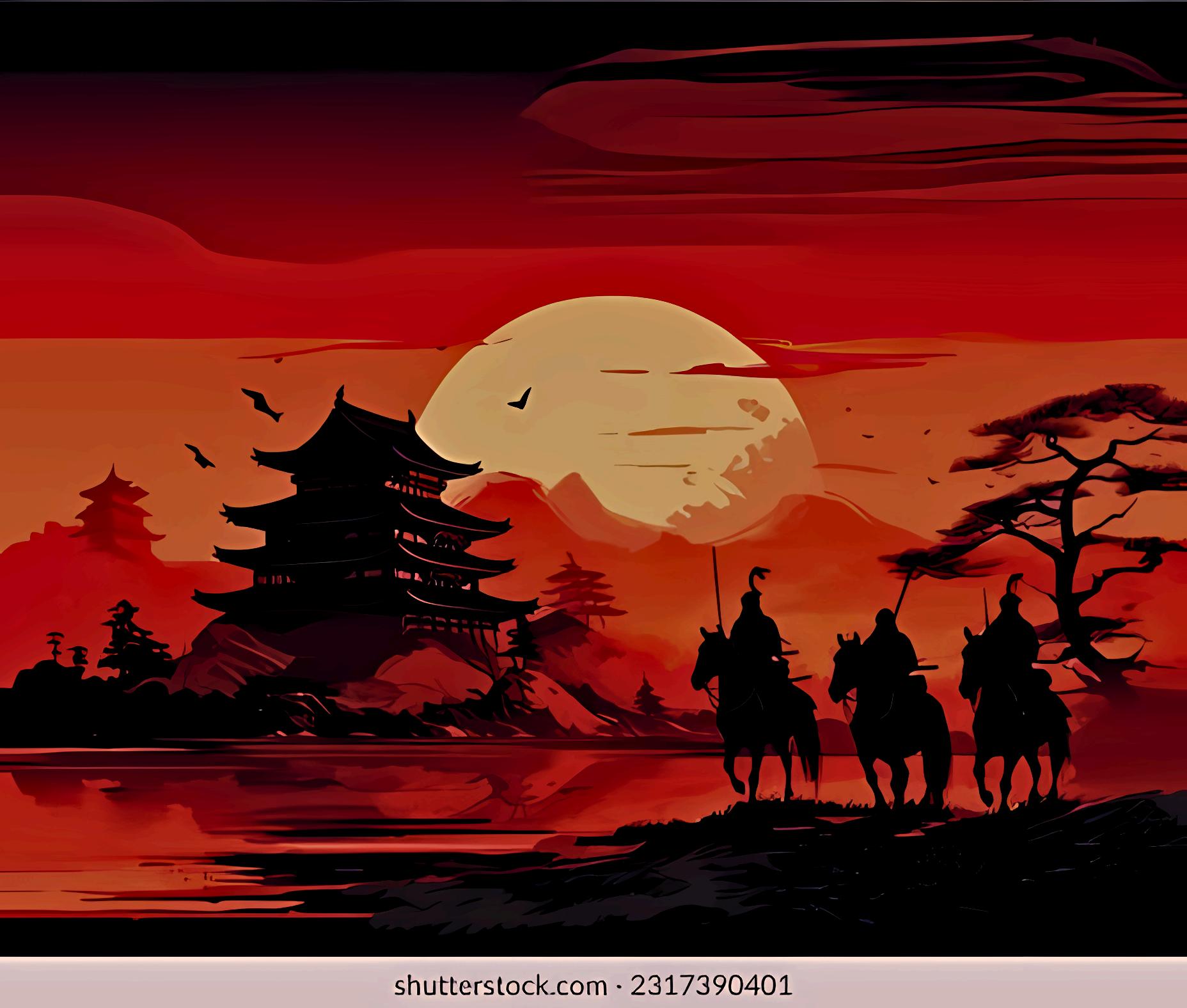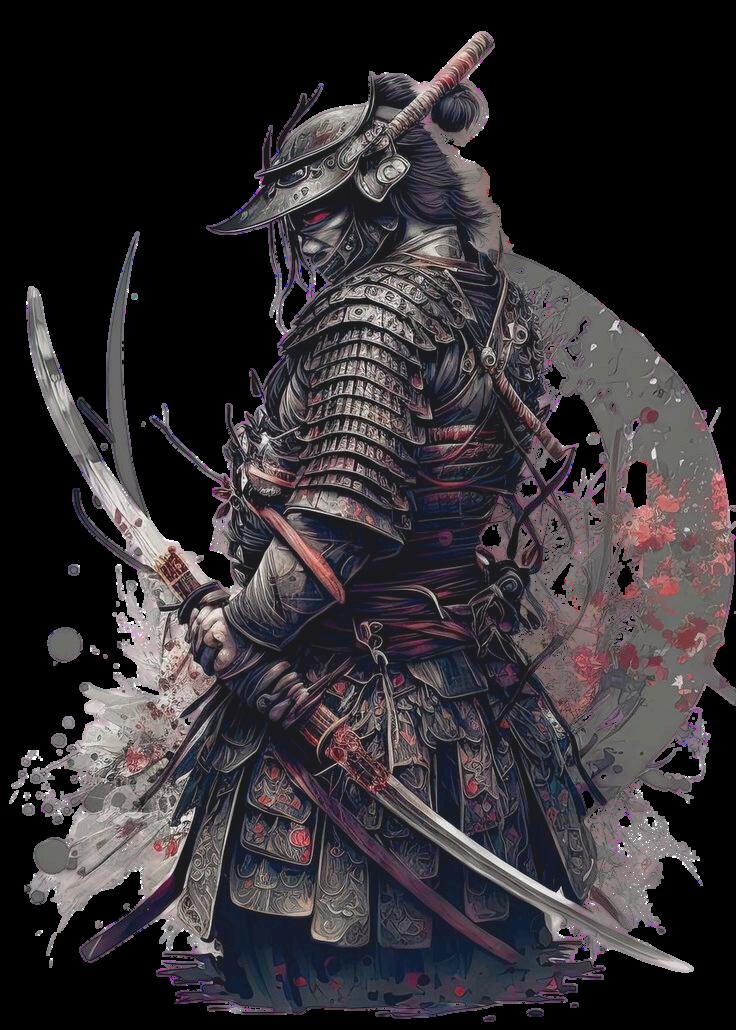
11 minute read
47 RONIN
Morality of the Samurai
By Sumiko Nakano
In the early 18th century, Japan was under the rule of the Tokugawa shogunate, a period known as the Edo period. This era was marked by strict social order, economic growth, and isolationist foreign policies The Tokugawa family, who led the shogunate, maintained peace and stability through a rigid class structure and a powerful military government.
At the heart of this society were the samurai, warrior-aristocrats bound by the Bushido code. Bushido, meaning "the way of the warrior," emphasized loyalty, honor, bravery, and self-discipline. Samurai were expected to live and die by these principles, dedicating their lives to serving their daimyo, or feudal lords, and maintaining their own personal honor. Daimyo were powerful landholding lords who controlled vast territories and commanded armies of samurai. They ruled their domains autonomously but were required to remain loyal to the Tokugawa regime, navigating a complex political landscape that often led to rivalries and conflicts
The story of the 47 Ronin centers on Asano Naganori, the daimyo of Ako Domain, and Kira Yoshinaka, a high-ranking shogunate official. Asano was appointed to receive and entertain envoys from the Imperial Court in Kyoto, a prestigious duty that required strict adherence to court etiquette. Kira, responsible for instructing Asano in these protocols, was known for his greed and corruption.
In early 1701, preparations for receiving the envoys began. Tensions between Asano and Kira escalated due to Kira's persistent demands for bribes, which Asano refused to pay. On March 14, 1701, while inside Edo Castle, Kira insulted Asano, possibly mocking his provincial background and questioning his understanding of court procedures
Enraged and unable to contain his anger, Asano drew his sword and attacked Kira, wounding him but not killing him.
Drawing a weapon within the shogun’s palace was a severe breach of protocol and law. The shogunate responded swiftly: Asano was arrested and ordered to commit seppuku, a form of ritual suicide that allowed him to die with honor. On the same day, March 14, 1701, Asano carried out this order, disemboweling himself as per the ritual, and was subsequently decapitated by a kaishakunin, a second who ensured a quick death.
The death of Asano Naganori on March 14, 1701, cast a shadow over his loyal samurai. With their lord's ordered seppuku, they were thrust into the precarious existence of ronin. In the rigid social hierarchy of the Edo period, being a ronin was a fate laced with social and personal turmoil
For the samurai, their identity and honor were inextricably linked to their daimyo and their domain. With Asano’s death and the confiscation of his lands, these warriors lost not only their source of income but also their place in society. They were no longer retainers of a powerful lord but wandering, masterless samurai This sudden shift from samurai to ronin brought with it a profound sense of disgrace. Bushido, the way of the warrior, demanded unwavering loyalty to one's lord, and failing to protect or avenge him was seen as a deep failure.
In feudal Japan, ronin were often viewed with suspicion and contempt. Unlike samurai who served a daimyo, ronin lacked the stability and respectability of a formal position. They were seen as drifters and, sometimes, as troublemakers prone to banditry or mercenary work. This stigma only added to their social ostracism, making life as a ronin difficult and humiliating

The psychological toll on Asano’s samurai was immense. The shock of their lord’s death, coupled with the immediate loss of their purpose and honor, plunged them into despair. The ideals they had lived by loyalty, honor, and duty now demanded that they avenge Asano's death, regardless of the personal cost
The need for vengeance was rooted in the samurai’s code and their perception of justice Although Asano had indeed drawn his sword within Edo Castle, which was an undeniable breach of protocol, many of his retainers and contemporaries viewed the circumstances as unfairly harsh. Asano was repeatedly provoked by Kira Yoshinaka, who was widely recognized as a corrupt and manipulative official.
The samurai believed that Kira's actions had driven their lord to his breaking point, and that Asano’s punishment did not fit the provocations he had endured. In their eyes, Kira’s continuous dishonor towards Asano warranted retribution, and the failure of the shogunate to penalize Kira only deepened their sense of injustice.
Amidst this turmoil, Oishi Kuranosuke, the chief retainer of Asano, emerged as a beacon of resolve and leadership. Recognizing the need to restore their honor, Oishi began to orchestrate a plan for revenge. His calm and strategic mind were crucial in guiding the ronin through their darkest hours. Oishi's leadership provided a sense of purpose and unity, rallying the ronin around a single, unwavering goal: to avenge their master
For nearly two years, the ronin lived ordinary lives, dispersing to avoid suspicion. They took on various occupations and concealed their true intentions, biding their time and gathering intelligence on Kira Yoshinaka. This period of waiting and meticulous planning was a testament to their patience and dedication to Bushido.
Their commitment to avenging Asano's death, despite the personal risks, reflected the core values of loyalty and honor. They understood that their quest for vengeance would likely end in their own deaths, yet they remained steadfast in their resolve. Their journey was not just about retribution; it was about restoring the honor of their master and themselves.
By avenging Asano, the ronin believed they could right the wrongs inflicted upon their lord, challenge the corruption embodied by Kira, and demonstrate their unwavering loyalty and adherence to Bushido. Their actions were meant to honor Asano’s memory, showing that even in death, a samurai’s spirit and duty to their lord could transcend the grave.
The carefully laid plans of the 47 ronin culminated on a cold winter night, nearly two years after their lord’s death. On December 14, 1702, their moment of retribution finally arrived.
Under the leadership of Oishi Kuranosuke, the ronin gathered in Edo, their resolve hardened by months of meticulous planning and unwavering commitment to their cause.
The attack on Kira Yoshinaka's mansion was as methodical as it was swift. The ronin split into two groups, one led by Oishi himself and the other by his son, Oishi Chikara. They approached the mansion under the cover of darkness, taking up positions at the front and rear gates Despite the freezing weather, their spirits burned with the fire of vengeance.
Kira’s mansion was heavily guarded, a testament to his fear of retribution. The ronin, however, were undeterred. At the signal from Oishi, the attack began. They sounded a drum to announce their presence, a bold declaration that they had come to exact their revenge.
The guards, caught unaware by the sudden assault, were quickly overwhelmed by the ronin's fierce determination and strategic prowess
The ronin methodically moved through the mansion, neutralizing guards and searching for Kira The battle was intense but shortlived. The element of surprise, combined with their disciplined approach, gave the ronin the upper hand. Remarkably, none of the ronin were killed during the attack, a testament to their careful planning and execution. They suffered some injuries, but their determination carried them through. Kira, realizing his life was in grave danger, attempted to hide in a storage shed. However, the ronin were thorough in their search.
After a meticulous sweep of the mansion, they found Kira cowering in the shed, dressed in his nightclothes and trembling with fear. Oishi Kuranosuke, recognizing the man who had caused so much suffering, approached him with a grim sense of justice.
Kira was offered the chance to commit seppuku, to die with some measure of honor. He refused, paralyzed by fear. Seeing that Kira would not take his own life, Oishi Kuranosuke stepped forward and, with a single decisive stroke, beheaded Kira Yoshinaka. The ronin had fulfilled their vow. They had avenged their lord and restored his honor.
With Kira’s head in their possession, the ronin marched through the streets of Edo to Sengakuji Temple. There, they washed Kira’s head in a well and presented it at the grave of their master, Asano Naganori.
This act completed their duty, signifying the restoration of Asano’s honor and the fulfillment of their samurai obligation.
As dawn broke, the ronin surrendered themselves to the authorities. They made no attempt to flee or resist arrest, fully aware that their actions would have severe consequences.

Their bravery and adherence to the Bushido code had transformed them from disgraced ronin into paragons of loyalty and honor.
With the dawn of a new day, the ronin, having fulfilled their duty, surrendered themselves to the authorities. Their bravery and adherence to the Bushido code had transformed them from disgraced ronin into paragons of loyalty and honor.
The shogunate was faced with a complex decision. The ronin had undeniably broken the law by taking Kira's life, but their actions were also viewed with admiration by many who saw their unwavering loyalty and courage as the highest expression of samurai virtue. After much deliberation, the authorities decreed that the ronin would be allowed to die with honor.
On February 4, 1703, 47 ronin were ordered to commit seppuku, the ritual suicide that would allow them to restore their honor fully. However, only 46 ronin carried out this final act. One ronin, Terasaka Kichiemon, was spared from this fate. There are various accounts as to why he survived. Some suggest that he was sent away during the raid to inform others of their actions, ensuring the story of their loyalty and vengeance would be told. Others believe he was simply fortunate to survive the final roundup. Regardless of the reason, Terasaka Kichiemon lived to tell the tale of his comrades' ultimate sacrifice, and his survival allowed the story of the 47 ronin to endure.
The ritual of seppuku was solemn and precise. Each ronin dressed in a white kimono, symbolizing purity, and was provided with a tanto, a short ceremonial blade. They performed the ritual with calm dignity, demonstrating the bravery and discipline that defined their lives. A trusted comrade, known as a kaishakunin, stood by to deliver a swift decapitation to ensure a quick and honorable death.
As the 46 ronin faced their deaths with unwavering resolve, their final moments were a testament to the principles they held dear Each man met his end with the same courage and honor that had driven them to avenge their master. Their collective seppuku was unprecedented in its scale and impact, leaving an indelible mark on Japanese history and culture.
The ronin were buried alongside their beloved master, Asano Naganori, at Sengakuji Temple Their graves became a pilgrimage site, drawing countless visitors who came to pay their respects to these iconic figures of loyalty and honor. The story of the 47 ronin, from their master’s disgrace to their own honorable deaths, etched their legacy into the annals of Japanese history.
Their tale is one of unwavering commitment, meticulous planning, and the ultimate sacrifice in the name of loyalty and honor. Their actions carry a profound weight that resonates through the ages.
In the centuries that followed, the story of the 47 Ronin continued to inspire and captivate people worldwide. It has been retold in countless forms of literature, theater, and film, each adaptation preserving the essence of their extraordinary courage and dedication.
The legacy of the 47 ronin is a powerful reminder of the enduring power of loyalty, honor, and the samurai spirit, resonating through the ages and continuing to inspire generations to come.
As the 46 ronin faced their deaths with unwavering resolve, their final moments were a testament to the principles they held dear. Each man met his end with the same courage and honor that had driven them to avenge their master. Their collective seppuku was unprecedented in its scale and impact, leaving an indelible mark on Japanese history and culture.
The ronin were buried alongside their beloved master, Asano Naganori, at Sengakuji Temple. Their graves became a pilgrimage site, drawing countless visitors who came to pay their respects to these iconic figures of loyalty and honor The story of the 47 ronin, from their master’s disgrace to their own honorable deaths, etched their legacy into the annals of Japanese history.
Their tale is one of unwavering commitment, meticulous planning, and the ultimate sacrifice in the name of loyalty and honor. Their actions carry a profound weight that resonates through the ages.
In the centuries that followed, the story of the 47 Ronin continued to inspire and captivate people worldwide. It has been retold in countless forms of literature, theater, and film, each adaptation preserving the essence of their extraordinary courage and dedication.
The legacy of the 47 ronin is a powerful reminder of the enduring power of loyalty, honor, and the samurai spirit, resonating through the ages and continuing to inspire generations to come.









